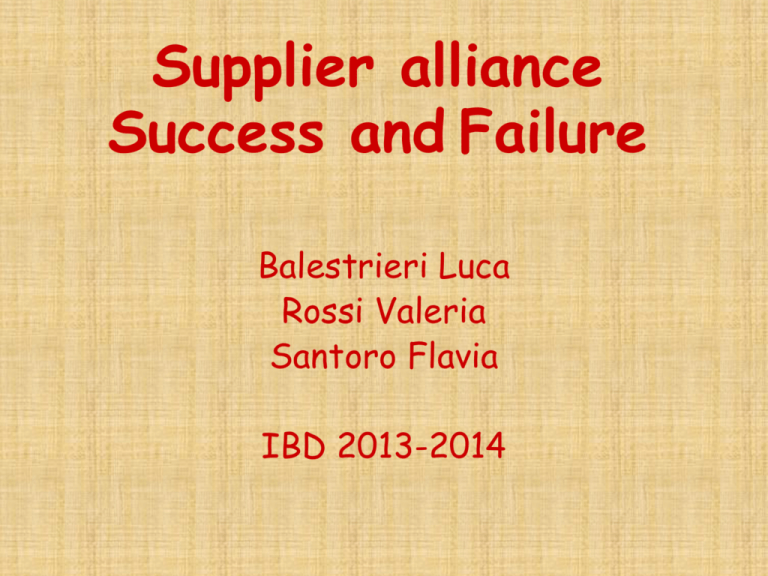Diapositiva 1
advertisement

Supplier alliance Success and Failure Balestrieri Luca Rossi Valeria Santoro Flavia IBD 2013-2014 How did we end up with supplier alliances? • Two main concepts led to the born of supplier alliances: – Specialization – Comparative advantage Adam Smith, 1776 Labour division ”One man draws out the wire, another straights it, a third cuts it, a fourth points it, a fifth grinds it at the top for receiving the head: to make the head requires two or three distinct operations: to put it on is a particular business, to whiten the pins is another ... and the important business of making a pin is, in this manner, divided into about eighteen distinct operations, which in some manufactories are all performed by distinct hands, though in others the same man will sometime perform two or three of them.” Michael Porter, 1985 Specialization of stages • Firms spent too much time and money performing stages and activities where they had no comparative/competitive advantage • Firms should focus on what they do best and outsource the rest 2nd unbundling • Functional specialization of firms was made possible by ICT: – Coordinate complexity at distance – Tear down transactional costs • Geographical unbundling to meet comparative advantage (most abundant resources) Economies of specialization extension of the division of labour between firms thanks to trade C ACa ACc ACb Q Global Value Chain GVC • Great increase of trade • Hub-and-spoke asymmetry between “factory” economies and “headquarter” economies (dependency of the former) • Trade especially about parts and components: building up of Global Supply Chain • “Spoke” firms: need to strengthen these links with suppliers Walmart supply chain Supplier alliances • Supplier alliances: a form of IORs • IOR: strategic relationships in which both parties benefit in working together rather than individually, in a medium-long term • Alternative forms of IOR are: Joint Ventures, Mergers, Acquisitions and Licensing • This type of cooperation involves share of capitals, technologies, human resources, knowhow and other assets Why do they form? • Technology development, risk management and cost reduction (Dore, 1987; Mowery, 1988) • Technological complexity and Technological uncertainty (Dodgson, 1991) • Attractive in situations where there is a need for: reliable information, to provide stability in contractual dealings and for large organizations to become more dynamic (Powell 1987) Dynamicity • Each party’s objectives, contributions and benefits might change over time • Once established: they evolve to a more informal and interpersonal relationship • Nevertheless, trust and commitment are at the base of supplier alliances Research methodology • 4 hypotheses: – Strong alliances: higher level of productivity and quality – Relationship between trend alliance and use of subordinated power – Positive results with the development of personal relationship – Trends predictions (buyers and suppliers perspectives) Results • Hypotheses 1, 3, 4 are supported by Ian Stuart • Hypotheses 2: any support that subordinated power is able to explain supplier alliance trends • Finally, both parties gain satisfaction from stable and long lasting alliances Applications • Article main points: – Beyond common transactional-based agreements – Extreme cases of buyer-seller relationships • Case study: Mark&Spencer and Walmart Mark&Spencer “We’re only as strong as the communities in which we trade, so it makes good sense for us to be a fair partner – paying a fair price to suppliers, supporting local communities and ensuring good working conditions for everyone involved in our supply chains.” http://www.youtube.com/watch?v=ytbk3DHNrtQ Achieved performance Small suppliers • Aim: Increasing M&S use of small local suppliers by improving the understanding of M&S buying teams of the different needs of small producers • To access the innovation that can be provided by small suppliers, M&S has actively provided extra support to a range of new small suppliers of specialty food and drink and regional breweries • 2007: Mark&Spencer Business Plan A • Pillar 6 deals with the topic of Fair Partner Successful cooperation with Kenya suppliers of tea and coffee, able to share the profits Failure in cotton agreements: only cover 1% of M&S total cotton use, due to a combination of poor availability of material and the complexities of cotton supply chains Achieved performance Supplier exchange • Aim: Launching a Supplier Exchange to drive best practices, stimulate innovation and help suppliers secure funds to develop more sustainable production techniques and invest in their workforces and local communities • Progress summary: New guidelines on water efficiency, wood sourcing, waste, bio-fuels, ‘green’ factories and social compliance Walmart criticism How is it possible? • A $5,97 t-shirt journey: Factory-ShippingWarehouse-Store – Factory: 30,000 Chinese factories are the 70% of the total production, poor wages, high flexibility – Warehouse: Stressful and dangerous environment, low wages, no health insurance – Store: $8,81 per hour X 34 hours X 52 weeks = $15,576 annual income (below Federal Poverty Level) Made in Bangladesh • • • • • 5,000 factories 4,5 million workers $0,32 per hour→$38 per month 7 days a week November 2012: Fire in Tazreen factory, 117 workers died. Walmart refused to pay more to upgrade Bangladeshis factory buildings • April 2013: collapse of Rana Plaza buildings, 1129 workers died →companies signed the UNI Fire&Building Accord, Walmart refused Conclusions • Main points we covered: – Labour and stage specialization – The born of Global Supply Chain GSC – Supplier alliances as a way to deal with GSC – How to make those alliances long-lasting, profitable and therefore successful – Social issues related to GSC: dark side of GSC and the possibility to spread standards of living and working also through suppliers alliances. THANKS FOR YOUR ATTENTION • References: – http://www.youtube.com/watch?v=yZC4neLax5o – http://www.youtube.com/watch?v=ytbk3DHNrtQ – http://www.networkdessous.com/pdf_dossier/2008/Quando %20i%20grandi%20si%20convertono%20al%20verde_Specia le%20MARK&SP_LII_7-08.pdf – www.marksandspencer.com/plana – www.marksandspencer.com/thecompany – www.walmart.com – www.uniglobalunion.org – www.cepr.org/pubs/dps/DP9103.asp






